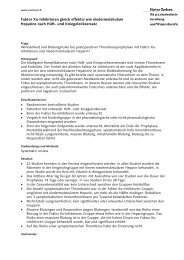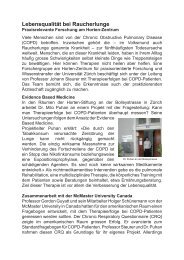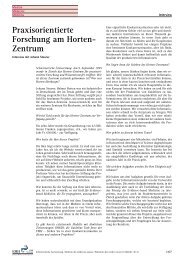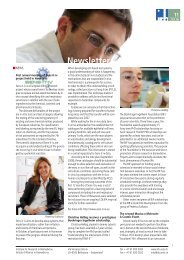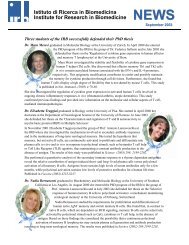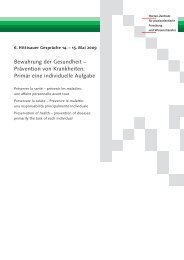Annals of Internal Medicine - Helmut Horten Stiftung
Annals of Internal Medicine - Helmut Horten Stiftung
Annals of Internal Medicine - Helmut Horten Stiftung
You also want an ePaper? Increase the reach of your titles
YUMPU automatically turns print PDFs into web optimized ePapers that Google loves.
Article Interval Exercise for Patients with Chronic Obstructive Pulmonary Disease<br />
Thus, with the same number and duration <strong>of</strong> exercise sessions<br />
as those in the continuous exercise group, patients in<br />
the interval exercise group achieved similar improvements<br />
in health-related quality <strong>of</strong> life, the main outcome in respiratory<br />
rehabilitation trials, and exercise capacity. This indicates<br />
that the short high-intensity stimuli (on average<br />
98% <strong>of</strong> maximum exercise capacity) were effective in provoking<br />
a response similar to that <strong>of</strong> a constant workload at<br />
57% <strong>of</strong> maximum exercise capacity. The length <strong>of</strong> our<br />
training session was limited to approximately 25 minutes, a<br />
tolerable length for patients with severe COPD. It is possible,<br />
however, that patients could endure longer exercise<br />
sessions with interval exercise than with continuous exercise,<br />
allowing for an increase in training effects (20). This<br />
hypothesis needs to be addressed in future studies.<br />
The main CRQ follow-up assessment occurred after 5<br />
weeks because items on the CRQ relate to activities in the<br />
home. Patients also completed the CRQ after inpatient<br />
rehabilitation (3-week follow-up), and we found even<br />
larger changes for the interval exercise group compared<br />
with the continuous exercise group (adjusted betweengroup<br />
difference, 0.26 [CI, �0.11 to 0.63] favoring interval<br />
exercise). Thus, interval exercise was clearly noninferior<br />
at this stage.<br />
Clinicians need to identify patients with COPD who<br />
might benefit from respiratory rehabilitation. Some patients<br />
can tolerate continuous exercise at high intensity, but<br />
our study and another study show that most patients with<br />
severe COPD are not able to sustain a continuous exercise<br />
protocol (20). For these patients, interval exercise represents<br />
an attractive alternative because it <strong>of</strong>fers the same<br />
benefit as high-intensity exercise but is better tolerated.<br />
Clinicians can choose between interval and continuous exercise<br />
to initiate physical activity according to patient preference,<br />
allowing a larger proportion <strong>of</strong> patients with severe<br />
COPD to improve their peripheral muscle dysfunction.<br />
Our findings strengthen the evidence base for interval exercise<br />
and may lead the American Thoracic Society and<br />
European Respiratory Society to strengthen their recommendations<br />
for this protocol (19).<br />
From University <strong>of</strong> Zurich, Zurich, Switzerland; Klinik Barmelweid,<br />
Barmelweid, Switzerland; McMaster University, Hamilton, Ontario,<br />
Canada; University at Buffalo, Buffalo, New York; Italian National Cancer<br />
Institute Regina Elena, Rome, Italy; and University <strong>of</strong> Basel, Basel,<br />
Switzerland.<br />
Acknowledgments: The authors thank the physiotherapists and physicians<br />
who participated in the study. They also thank Pr<strong>of</strong>essor Patrick<br />
Bossuyt, PhD, University <strong>of</strong> Amsterdam, the Netherlands, for his valuable<br />
comments.<br />
Grant Support: By AstraZeneca Switzerland (unrestricted grant), Boehringer<br />
Ingelheim Switzerland (unrestricted grant), and Klinik Barmelweid.<br />
Potential Financial Conflicts <strong>of</strong> Interest: None disclosed.<br />
Requests for Single Reprints: Milo A. Puhan, MD, PhD, <strong>Horten</strong><br />
Centre, University Hospital <strong>of</strong> Zurich, Postfach Nord, CH-8091 Zurich,<br />
Switzerland; e-mail, milo.puhan@usz.ch.<br />
Current author addresses and author contributions are available at www<br />
.annals.org.<br />
References<br />
1. Celli BR, Cote CG, Marin JM, Casanova C, Montes de Oca M, Mendez<br />
RA, et al. The body-mass index, airflow obstruction, dyspnea, and exercise capacity<br />
index in chronic obstructive pulmonary disease. N Engl J Med. 2004;350:<br />
1005-12. [PMID: 14999112]<br />
2. Garcia-Aymerich J, Farrero E, Félez MA, Izquierdo J, Marrades RM, Antó<br />
JM, et al. Risk factors <strong>of</strong> readmission to hospital for a COPD exacerbation: a<br />
prospective study. Thorax. 2003;58:100-5. [PMID: 12554887]<br />
3. Decramer M, Gosselink R, Troosters T, Verschueren M, Evers G. Muscle<br />
weakness is related to utilization <strong>of</strong> health care resources in COPD patients. Eur<br />
Respir J. 1997;10:417-23. [PMID: 9042643]<br />
4. Pitta F, Troosters T, Spruit MA, Probst VS, Decramer M, Gosselink R.<br />
Characteristics <strong>of</strong> physical activities in daily life in chronic obstructive pulmonary<br />
disease. Am J Respir Crit Care Med. 2005;171:972-7. [PMID: 15665324]<br />
5. Global Initiative for Chronic Obstructive Pulmonary Disease. Guidelines:<br />
Workshop Report 2005. Available at www.goldcopd.com/GuidelineItem.asp<br />
?intId�1387. Accessed on 16 June 2006.<br />
6. Chronic obstructive pulmonary disease. National clinical guideline on management<br />
<strong>of</strong> chronic obstructive pulmonary disease in adults in primary and secondary<br />
care. Thorax. 2004;59 Suppl 1:1-232. [PMID: 15041752]<br />
7. Lacasse Y, Brosseau L, Milne S, Martin S, Wong E, Guyatt GH, et al.<br />
Pulmonary rehabilitation for chronic obstructive pulmonary disease. Cochrane<br />
Database Syst Rev. 2002:CD003793. [PMID: 12137716]<br />
8. Puhan MA, Scharplatz M, Troosters T, Steurer J. Respiratory rehabilitation<br />
after acute exacerbation <strong>of</strong> COPD may reduce risk for readmission and mortality—a<br />
systematic review. Respir Res. 2005;6:54. [PMID: 15943867]<br />
9. Cote CG, Celli BR. Pulmonary rehabilitation and the BODE index in<br />
COPD. Eur Respir J. 2005;26:630-6. [PMID: 16204593]<br />
10. Troosters T, Gosselink R, Decramer M. Exercise training in COPD: how to<br />
distinguish responders from nonresponders. J Cardiopulm Rehabil. 2001;21:<br />
10-7. [PMID: 11271652]<br />
11. American Thoracic Society and European Respiratory Society. Management<br />
<strong>of</strong> stable COPD: pulmonary rehabilitation. Standards for diagnosis and management<br />
<strong>of</strong> patients with COPD. 2004. Accessed at www.ersnet.org/lrPresentations<br />
/copd/files/main/index.html on 9 August 2006.<br />
12. Pulmonary rehabilitation-1999. American Thoracic Society. Am J Respir Crit<br />
Care Med. 1999;159:1666-82. [PMID: 10228143]<br />
13. Cambach W, Chadwick-Straver RV, Wagenaar RC, van Keimpema AR,<br />
Kemper HC. The effects <strong>of</strong> a community-based pulmonary rehabilitation programme<br />
on exercise tolerance and quality <strong>of</strong> life: a randomized controlled trial.<br />
Eur Respir J. 1997;10:104-13. [PMID: 9032501]<br />
14. Wijkstra PJ, Van Altena R, Kraan J, Otten V, Postma DS, Koëter GH.<br />
Quality <strong>of</strong> life in patients with chronic obstructive pulmonary disease improves<br />
after rehabilitation at home. Eur Respir J. 1994;7:269-73. [PMID: 8162979]<br />
15. Troosters T, Gosselink R, Decramer M. Short- and long-term effects <strong>of</strong><br />
outpatient rehabilitation in patients with chronic obstructive pulmonary disease: a<br />
randomized trial. Am J Med. 2000;109:207-12. [PMID: 10974183]<br />
16. Griffiths TL, Burr ML, Campbell IA, Lewis-Jenkins V, Mullins J, Shiels K,<br />
et al. Results at 1 year <strong>of</strong> outpatient multidisciplinary pulmonary rehabilitation: a<br />
randomised controlled trial. Lancet. 2000;355:362-8. [PMID: 10665556]<br />
17. Maltais F, LeBlanc P, Jobin J, Bérubé C, Bruneau J, Carrier L, et al.<br />
Intensity <strong>of</strong> training and physiologic adaptation in patients with chronic obstructive<br />
pulmonary disease. Am J Respir Crit Care Med. 1997;155:555-61. [PMID:<br />
9032194]<br />
18. Coppoolse R, Schols AM, Baarends EM, Mostert R, Akkermans MA,<br />
Janssen PP, et al. Interval versus continuous training in patients with severe<br />
COPD: a randomized clinical trial. Eur Respir J. 1999;14:258-63. [PMID:<br />
10515398]<br />
19. Vogiatzis I, Nanas S, Roussos C. Interval training as an alternative modality<br />
to continuous exercise in patients with COPD. Eur Respir J. 2002;20:12-9.<br />
[PMID: 12166558]<br />
824 5 December 2006 <strong>Annals</strong> <strong>of</strong> <strong>Internal</strong> <strong>Medicine</strong> Volume 145 Number 11 www.annals.org



